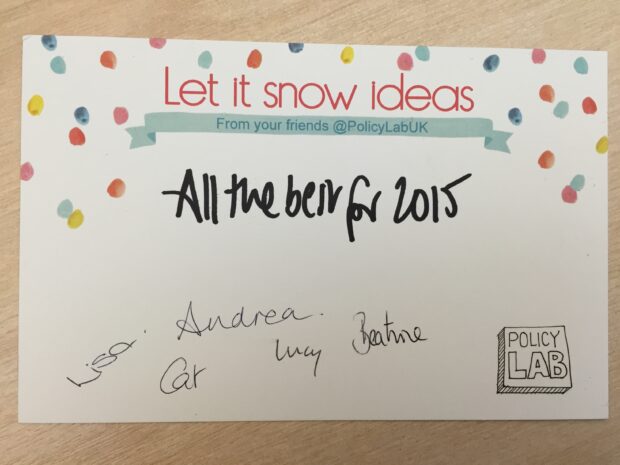Given 2014 is drawing to a close we thought we would look to the future, beat the Sunday papers to it, and canter through some of the emerging trends and ideas vying to shape 2015. So this week Policy Lab held a joint event with the Design Council and UKTI Ideas Lab: Future Present.
For Policy Lab it was a chance to connect with the many people who have been helping deliver our projects with departments. It was also a chance to pause and hear from six inspirational experts with their own unique take on the future. The talks by Skype, Barclays, Stylus, Ipsos MORI, FutureGov and Sense Worldwide were united by one question – what inspires you about the future?
It was amazing to see how quickly and seemingly effortlessly digital, data and design are transforming almost all aspects of our lives. Many of the speakers are designers, so whilst technology was often the enabler, the focus was more often on what it can do for people. Carrie Bishop of FutureGov challenged us to rethink vulnerability from the point of view of real service users, making the point that in a network age we have far more opportunities to design greater resilience into our public services than we might first think.
Following this, Gideon gave us the big picture, revealing the trends and drivers from ‘Trust to Tradition’ that IPSOS Mori have been tracking in their Global Trends survey. The UK and US top the list of countries where people think decisions about public services are better if they are made locally.
Of course both perspectives are important, the big picture helps us identify patterns and the user perspective helps us identify meaning. For example, in the Lab we often talk about the importance of bringing together ‘big data’ and ‘thick data’. Big data of tells us ‘what’, whereas ‘thick data’ offers new perspectives, by giving us more detail about the ‘why’.
Yet it was also clear, as the talks unfolded, that in the white heat of change a kind of mesmeric buzz can make it hard to retain perspective – to sort the wheat from the chaff. So many new ideas and ideologies are competing for our limited attention span, from the emergence of ‘broga’ [men only yoga] to potential game-changers like HBR’s ‘new power’. For this and other reasons, I love Gartner’s Hype curve as it reminds us that change is something that evolves - it flows in response to both our needs and aspirations. There are as many failed technologies as there are successes so we are wise to be wary - just because your fridge can give you a digital post it note, doesn’t mean it should. Antonia Ward of Stylus caught the sentiment of the room, though, by revealing how new technologies are not to be feared but to be navigated.
Next up, Steve Pearce of Skype got personal. He inspired us to use more of our natural talents and faculties, championing both right and left brain thinkers, challenging decision makers to not just analyse problems but to combine intellect and emotion to form a connected whole. We heard how emotions drive experiences, across a network of ‘seams’.
The ‘networked age’ was the meta-trend that seemed to unite all the talks. And it was fitting, therefore, that Jeremy Brown of the global sensing network Sense Worldwide raised the probability that we might soon reach ‘peak app’, the height of the hype curve, where at around 2.5 million apps the boundless possibilities make it much harder to choose: the paradox of choice is that more can be less.
But of course, the future doesn’t just happen – we create it. Through our everyday decisions, large and small. What future do we want to live in? How can it deliver better quality of life for more people? Clive Grinyer closed the evening by reminding us that even ten years ago the film ‘Minority Report’ was a more entertaining, beguiling, and believable glimpse of the future than any written report of that time, however well written or referenced. To change the future we must first imagine it is possible. This is where Labs around the world like us are experimenting with the art of the possible. As the pioneer behind the graphical user interface Alan Kay said, ‘The best way to predict the future is to invent it’.

For more news from Lab follow them @PolicyLabUK.